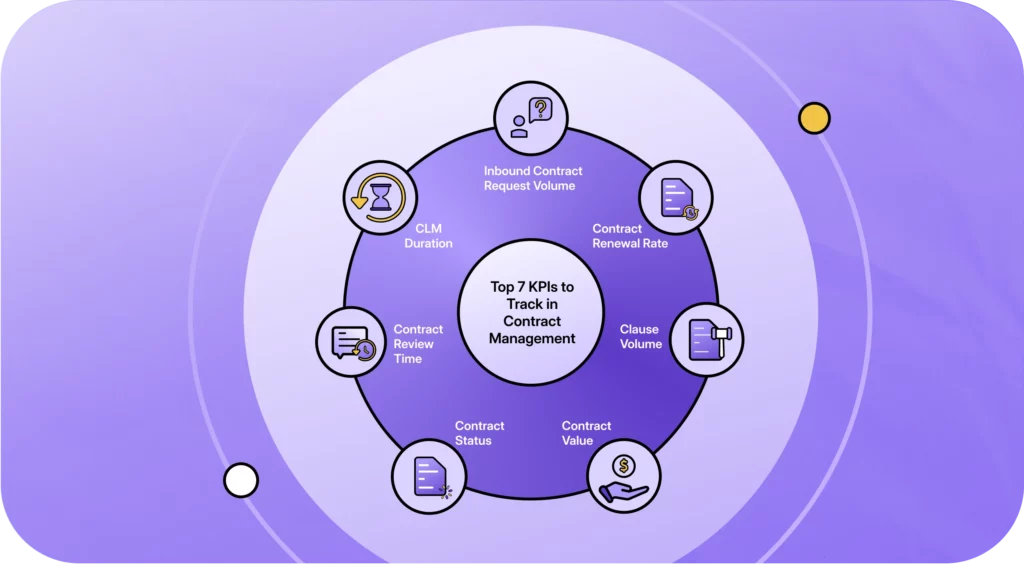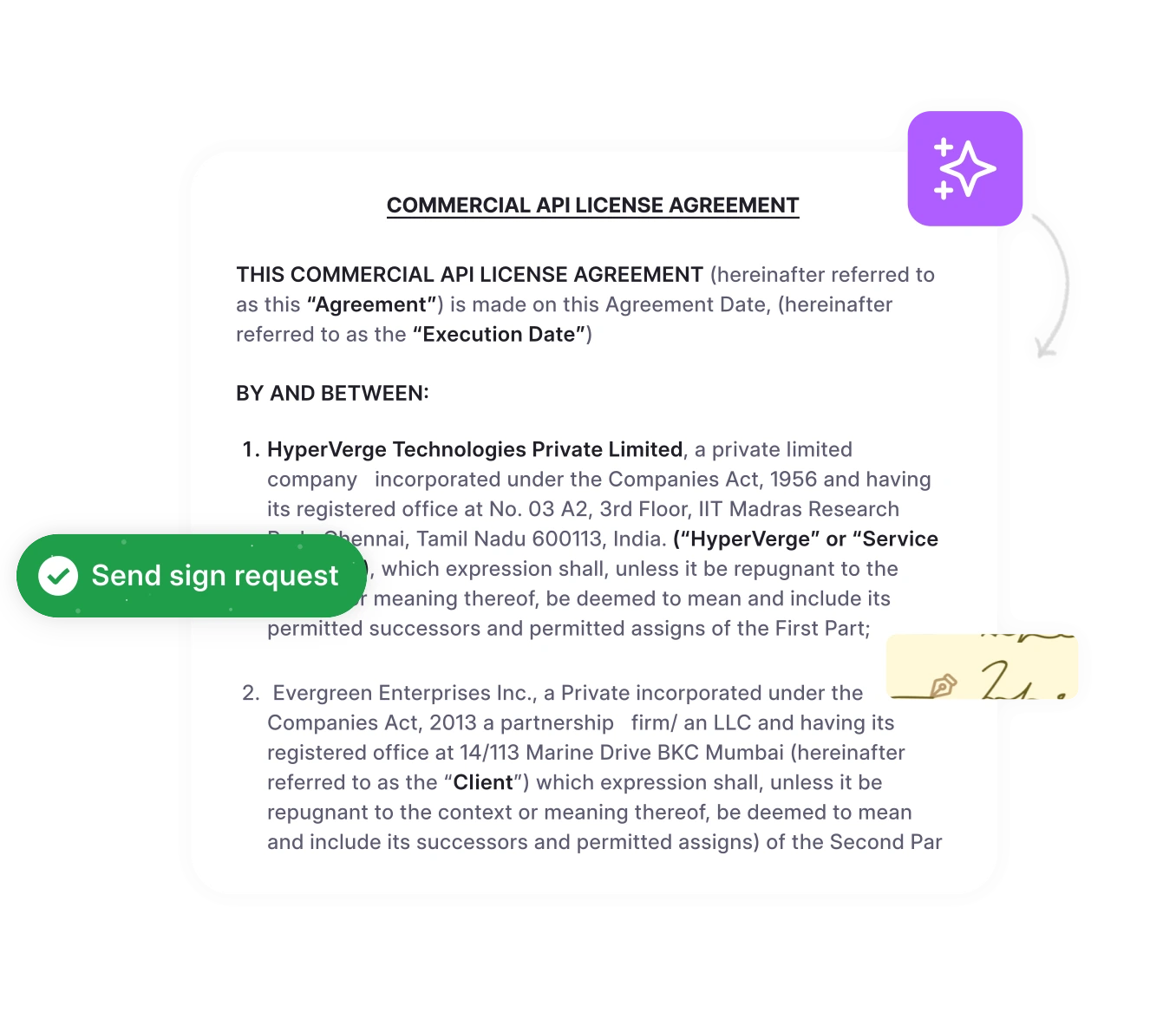Contracts play a crucial role in daily business operations, especially in industries like legal, procurement, and enterprise-level organizations, where efficient contract management directly impacts revenue and compliance. While effective contract management drives growth and smooth operations, poorly managed contracts lead to delays, increased risks, and costly errors.
A World Commerce and Contracting report shows that poor contract management can cost businesses up to 9% of their annual revenue, mainly due to missed obligations, legal risks, and inefficiencies.
By tracking KPI for contract management, your organization can measure the effectiveness of your contract administration processes and improve overall contract lifecycle management performance. These KPIs help you pinpoint inefficiencies, enhance operational performance, and uncover opportunities to streamline contract management operations. Whether you’re managing vendor agreements or client contracts, tracking KPIs ensures that your business stays compliant, minimizes risks, and boosts profitability.
This blog provides a detailed guide on tracking and leveraging contract management KPIs to improve your contract processes in 2025 and beyond.
What are KPIs in contract management?
Contract management key performance indicators (KPIs) are specific contract performance measures that evaluate the performance of your contract processes. These contract management performance metrics provide essential insights for business optimization.
These KPIs provide insights into contract compliance, efficiency, and risk management for the procurement department, legal teams, and enterprise contract managers. Tracking KPIs allows you to understand the state of your contracts, identify bottlenecks, and set performance benchmarks.
| For example, tracking the contract lifecycle duration KPI helps a procurement team identify delays in the approval process, allowing them to take action and close deals faster. |
Monitoring KPIs of contract managers, such as contract renewal rates or clause compliance, can help you proactively address issues, streamline processes, and ensure timely contract renewals.
Top 7 KPIs to streamline and optimize contract management

1. CLM duration
Definition: How long do your contract processes take from start to finish? The contract lifecycle management duration KPI helps you understand the time it takes to process your contract at each stage, serving as a key indicator of contract lifecycle management performance.: drafting, editing, negotiation, redlining, and signing.
Why It Matters: CLM duration is influenced by contract type, approval processes, available resources, and contract value. Monitoring this KPI helps identify bottlenecks, allowing teams to take steps to accelerate the CLM process. Visualizing this data through time series charts on a contract management KPI dashboard makes it easier to spot delays and improve efficiency.
Track and Execute Contracts Seamlessly
Take your contracts from creation to completion while monitoring key KPIs, only with HyperStart CLM.
Book a Demo2. Contract renewal rate
Definition: The contract renewal rate is the ratio of renewed contracts to expired contracts. A higher number of renewed contracts indicates customer retention, a positive customer experience, and sustainable income streams.
Why It Matters: Tracking contract renewals gives insight into client satisfaction and vendor loyalty. It highlights the effectiveness of your efforts in managing customer relationships and vendor partnerships, helping to improve retention strategies.
3. Number of clauses tracked
Definition: Missed contract milestones can result in legal penalties and risks. Tracking key clauses and obligations helps manage risks and opportunities proactively.
Why It Matters: By tracking key terms such as obligations, renewals, and deadlines, you can identify patterns, gaps, or risks in your contracts. This KPI helps ensure that contractual obligations are met on time, minimizing potential legal or financial liabilities.
4. Contract value
Definition: Contract value KPI is a metric that tracks the value of contracts signed during a particular period. It is one of the most important KPIs of contract management and directly correlates with business performance.
Why It Matters: Contract value assessments help track high and low-critical contract agreements. Moreover, tracking contract value, including annualized contract value, helps the legal team identify which contract clauses need priority review, improving efficiency, negotiation power, and revenue opportunities.
5. Contract status
Definition: Contract status helps you track where your contract is in the lifecycle in real time. Contract admins can establish granular controls and workflows and set benchmarks for contract TAT.
Why It Matters: Knowing which stage a contract is at—and who is responsible for the next action—prevents delays. Automated reminders can prompt relevant parties to take action, minimizing the time lost to manual follow-ups.
6. Contract review time
Definition: This contract management KPI calculates the time it takes for contract review, starting from contract initiation. The contract signing time depends on factors like contract complexity, number of contract requests, and the industry.
Why It Matters: Tracking this contractual KPI requires identifying all the pre-execution steps and calculating the time each step is taking. This helps evaluate the efficiency of each stage of the signing process and take steps to accelerate contract signing.
7. Number of inbound contract requests
Definition: The number of inbound contract requests refers to contract requests generated within the organization during a specific period. Tracking this KPI helps the legal team understand its workflow and allocate resources accordingly. This contract lifecycle management metrics is usually dependent on the legal professional-to-stakeholder ratio.
Why It Matters: Businesses can use this KPI to understand contract request generation trends during different times of the year. This helps get contract volume forecasts and plan contract management strategies effectively.
Monitor Your Contract Management KPIs
Ensure your contracts perform at their best by tracking KPIs with HyperStart CLM. Gain insights that drive better decisions.
Book a Demo8. Contract acceptance rate
Definition: The contract acceptance rate is a contract management KPI that tracks the percentage of contracts accepted without any revisions or negotiations. This metric is based on the total number of contracts versus the contracts with no changes.
Why It Matters: A high contract acceptance rate indicates contract efficiency and is a valuable metric to track. Moreover, monitoring clauses of contracts with high acceptance helps understand patterns in contract quality and further optimize the contract lifecycle.
9. Turn frequency
Definition: Turn frequency measures the number of back-and-forth revisions (turns) a contract undergoes before it is finalized. This KPI highlights the contract’s complexity and the negotiation process’s efficiency.
Why It Matters: A high turn frequency indicates complex negotiations, often pointing to unclear or non-standardized clauses. Reducing turn frequency through contract management kpi templates and standardized terms can help speed up contract finalization.
Why is tracking contract management KPIs important?
Like any other business process, contract lifecycle management requires routine checks. By effectively tracking contract metrics throughout the contract cycle, you can achieve measurable improvements to your contract lifecycle management performance. This data-driven approach helps ensure efficiency, productivity, and compliance across all contract stages. Let’s find out how.
1. Helps track contract lifecycle efficiency
Tracking contract management performance metrics helps
Gather contract performance tracking metrics for the admin process.
Identify and eliminate bottlenecks at specific stages of the contract lifecycle.
Accelerate the average contract turnaround time (TAT).
Watch and execute ongoing contracts effortlessly.
Unbottleneck critical contracts with name, status, turn, and template filters.
Prioritize and streamline action items and approval requests across teams and organizations.
2. Monitors contract obligations
No agreement is bulletproof. Tracking your contract’s risks through key performance indicators helps:
Keep track of contractual obligations, risks, and liabilities.
Visualize key contract data with auto-generated reports and contract analytics.
Proactively plan for and mitigate contract risks.
Automating obligation tracking and using real-time contract data empowers your team to close deals faster while mitigating risk and improving compliance. Utilizing contract process analytics is key to reducing TAT and minimizing contract risks.
3. Enhances contract compliance
Organizations can improve contract compliance monitoring by leveraging contract management performance metrics:
Regular analysis of contract data can uncover patterns and anomalies that indicate potential breaches.
Implementing corrective actions promptly.
Reducing the likelihood of legal and financial penalties
Let’s now delve into the top contract management KPIs to track.
5 actionable tips to efficiently track contract management KPIs
Manual tracking of multiple contract KPIs is inefficient and wasteful. Here are 5 actionable tips to help you effortlessly track your contract lifecycle performance.
1. Implement a CLM software
Contract lifecycle management software such as HyperStart CLM automates renewal tracking, and visualizes contract flows. Contract management systems monitors every stage of your contracting process with robust automation and AI capabilities.
To better understand how HyperStart CLM simplifies your contract management process, watch our product walkthrough video.
2. Define clear KPIs
Choosing the right KPIs helps generate valuable results from contract management KPI tracking. Align your KPIs with your business processes and industry to ensure meaningful insights and improve the performance of your contract portfolio.
3. Centralize contract data
Storing all your contract data in one place helps maintain a single source of truth. You can do this through contract management software offering central contract repository functionality.
4. Integrate other systems
CRM, HRMS, ERP systems, etc., manage contracts differently. Configuring these systems helps improve contract administration performance by consistently tracking all contract KPIs.
5. Set SMART goals
SMART (Specific, Measurable, Achievable, Result Oriented, and Time Constrained) contract KPIs give your contract processes a direction. They also help ensure your KPIs are realistic, relevant, and achievable.
These are some tips to help you get started with contract performance tracking. You need intelligent and automation-driven contract management software to track your contract management process’s performance and improve contract effectiveness using these KPIs, minus the manual efforts.
Why is it difficult to monitor contract management KPIs?
Tracking contract management KPIs is crucial, but many businesses face challenges sourcing and compiling relevant data. The primary issue is a need for more contract visibility.
Contracts are often scattered across multiple systems or stored in shared drives without proper organization, leading to a fragmented view. With a centralized system, businesses may know where their contracts are after signing, their terms, or how to efficiently share this information with relevant teams. This lack of a single source of truth makes tasks like contract audits and monitoring contract compliance highly inefficient and sometimes impossible.
The solution? With the right tools and contract management strategy, improving contract visibility and tracking contract management metrics can be simplified.
What is the best way to track contract management KPIs?
To effectively track contract management KPIs, consider using HyperStart CLM. Here’s how it simplifies KPI tracking:
1. Centralized contract repository
HyperStart stores all contracts in one unified platform, ensuring a single source of truth and providing visibility into all contract stages, including the contract cycle time.
2. Automated KPI tracking
HyperStart’s advanced automation tools allow teams to track contract performance measures in real-time, providing comprehensive contract metrics analysis. You can easily monitor contract turnaround times, renewal rates, and compliance metrics.
3. Customizable dashboards and reports
Generate custom reports to see your contracts’ progress and performance clearly from the contract management kpi dashboard. This makes it easy to assess KPIs at a glance.
4. Real-time workflow insights
HyperStart’s workflow tools allow you to quickly identify bottlenecks and areas where contracts get stuck, helping you streamline the contract lifecycle.
5. Advanced search and filter capabilities
Find and track specific contract data with advanced search filters, ensuring you can easily query contract obligations, terms, and deadlines.
Using HyperStart CLM, you gain full visibility and control over your contracts, making KPI tracking seamless and more accurate.
Automate contract KPI tracking with HyperStart CLM
Contract lifecycle management software is an excellent tool for optimizing your contract management process or tracking performance metrics. These tools help automate contractual processes and enable end-to-end contract tracking.
HyperStart CLM offers an end-to-end contract lifecycle management system to help you automate all stages of your contract lifecycle. Using HyperStart CLM enables you to experience complete contract management success.
From contract drafting, editing, redlining, and negotiation to signing, storing, and tracking contracts, HyperStart CLM is a complete suite. Book a demo with out team today to learn more.
Frequently asked questions
Yes, industry-specific benchmarks vary depending on factors like contract complexity and regulatory requirements. For example:
- In healthcare, contract lifecycle duration may be longer due to stricter compliance checks.
- In tech, a fast contract turnaround time (less than 30 days) may be essential for maintaining agility and competitiveness.
- In procurement, the contract renewal rate may be higher because of long-term supplier relationships.
- For vendor contracts, the contract value and renewal rate may be more critical as they directly affect supply chain stability and procurement costs.
- For customer contracts, contract acceptance rate and turn frequency may be more relevant as they impact customer satisfaction and revenue retention.
Yes, different KPIs are relevant depending on the stage of the contract lifecycle:
- Drafting and Negotiation: KPIs like turn frequency and review time are key to ensuring a smooth drafting and negotiation process.
- Execution: Contract lifecycle duration and contract status KPIs track how quickly contracts are finalized and signed.
- Post-Signing: Contract renewal rate and obligation tracking are critical in the post-execution stage to monitor performance and compliance.
Here are the contract management KPI examples:
- Example 1: Reducing contract lifecycle duration from 60 to 30 days through automation helped a SaaS company close deals faster and increase revenue.
- Example 2: Tracking the contract renewal rate enabled a logistics company to retain 90% of its vendors, reducing costs associated with new supplier acquisition.
Contract management performance is typically assessed using four key contract performance measures:
- Cost: Tracking whether contracts are executed within the agreed budget.
- Punctuality: Measuring if contract obligations are fulfilled on time.
- Reliability: Ensuring parties consistently meet contract terms.
- Consistent Quality: Monitoring the quality of deliverables throughout the contract lifecycle










